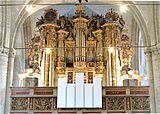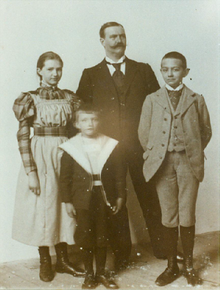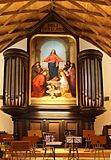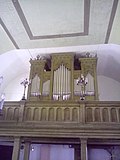Ernst Roever
Ernst Röver , actually Friedrich Wilhelm Ernst Röver, (born September 3, 1857 in Meierhof near Stade ; † March 22, 1923 in Hausneindorf , district of Quedlinburg) was a German organ builder of the late Romantic period in the last quarter of the 19th and early 20th centuries .
Life
Ernst Röver came as the son of Johann Hinrich Röver and the younger brother of Carl Johann Heinrich Röver from a family of organ builders in Stade , which had achieved regional importance in northern Germany. Both brothers learned organ building from their father and joined their father 's business in 1877 without years of traveling , which has since operated under the name of "Johann Hinrich Röver & Söhne OHG". After Ernst Röver left, Heinrich Röver continued the company until 1926, when it went out.
Ernst Röver married his first wife Gertrud († 1886) in 1883, with whom he had a son Ernst junior (1884–1963) and a daughter Gertrud. With his second wife, Luise († 1928), he had the son Hans (1890-1917) and the twin daughters Charlotte, who died at the age of one, and Irmgard (1901-1980).
When Emil Reubke, son of Adolf Reubke , died in 1884, Röver took over his company in Hausneindorf and left Stade. In the period that followed, the company experienced a strong boom. In 1890 a large production hall and a two-storey "organ hall" were completed. The company switched to steam operation and introduced the series production of individual parts. At the beginning of the First World War there were 25 employees.
Neither his son Ernst junior nor Hans became organ builders. The last two organs were built between 1916 and 1919. After that, only maintenance work and repairs are proven. Ernst Röver succumbed to the consequences of a stroke . The company went out shortly afterwards. Irmgard Röver guarded the closed workshop, but could not find anyone interested in the estate, which was largely disposed of after her death.
plant
Ernst Röver was interested in further developments in organ building and experimented on technical improvements in the area of the wind chest and the action . In this way a new type of transmission device , a register keyboard, a pneumatic combination device and a box drawer based on tube pneumatics were created. Johann Hinrich Röver got to know the first box store at Peter Tappe's, which he and his sons further developed in Stade. After this flapless wind chest was fully developed in 1886, Ernst Röver used it all his life. After the introduction of the pneumatic action in the Stade workshop in 1880, Ernst Röver reduced the sound delays by using the outflow principle instead of the inflow.
After Reubke's death, Röver completed his large new building in the St. Gertrud Church in Hamburg-Uhlenhorst (III / P / 46) with the new pneumatic box drawer. This brought him numerous follow-up orders. By 1921, around 50 new buildings were built in the Hamburg area alone. During the seven years of the joint Stader OHG, 20 new organs were built and in the 35 years in Hausneindorf (1884–1919) more than 200 new organs were built. From 1893 at the latest, five and from 1911 ten instruments per year were built. After 1911 production fell sharply. The workshop shifted to the construction of motorized aircraft and radio-controlled torpedoes for the armaments industry. Of the total of 78 preserved works, 57 are in the Prussian province of Saxony, today's Saxony-Anhalt .
The high number of basic voices and the restriction to three manuals are characteristic of his romantic organ works . Röver used high-quality materials and, with its developments, achieved a high level of functional reliability and immunity to interference. The largest organ built by Röver with three manuals and 101 registers was built in 1891 for the Nikolaikirche (Hamburg) and was destroyed in the bombing of Hamburg in 1943. Like many of his other works, his other large organ in Magdeburg Cathedral , which had over 100 registers, did not survive the Second World War either. Only one organ from Röver was exported abroad, an instrument from 1898 for the German Reformed community in Moscow (III / P / 38).
List of works (selection)
The list includes all of Röver's organs that have survived, as well as a few representative instruments that have been destroyed or replaced.
Italics indicate that the organ has not been preserved or only the historical case has been preserved. In the fifth column, the Roman number indicates the number of manuals and a capital "P" indicates an independent pedal . The Arabic number indicates the number of sounding registers . The last column provides information on the state of preservation or special features.
| year | place | church | image | Manuals | register | Remarks |
|---|---|---|---|---|---|---|
| 1884 | Luneburg | secondary school | II / P | 9 | not received | |
| 1885 | Badeborn | St. Viti | II / P | 20th | Reconstruction of the organ by Reubke (1880); completely preserved | |
| 1885 | Hohenleipisch | Village church |

|
II / P | 14th | receive |
| 1886 | Warnstedt (Thale) | St. George | II / P | 14th | Dismantled in 1980, transferred to Aken (Elbe) in 1986 , New Apostolic Church; receive | |
| 1888 | Quedlinburg | St. Benedict | III / P | 52 | Opus 10; 1943 rearranged somewhat; largely preserved → organ | |
| 1889 | Neinstedt | Lindenhof Church | II / P | 16 | 1931 extended to II / P / 19; receive | |
| 1889 | North Leda | St. Nicolai | II / P | 20th | Opus 15; completely preserved | |
| 1889 | Gatersleben | St. Stephani | II / P | 27 | Reconstruction of the organ by Reubke (1854); completely preserved | |
| 1890 | Berßel | St. Petri and Pauli | II / P | 18th | completely preserved | |
| 1890 | Ulzigerode | St. Peter and Paul | II / P | 15th | Opus 21; completely preserved | |
| 1891 | Hamburg | Nikolaikirche | III / P | 101 | Rövers largest organ; on July 28, 1943 church with organ destroyed | |
| 1891 | Weddersleben | St. Michael | II / P | 18th | completely preserved | |
| 1891 | Michaelstein Monastery | Instrument museum | I. | 4th | House organ Rövers; preserved and currently stored at Orgelbau Reinhard Hüfken | |
| 1889-1892 | North Leda | St. Nicolai | II / P | 20th | Restored in 2003; almost completely preserved | |
| 1892 | Hausneindorf | St. Petri | II / P | 25th | 1914 extended by Röver to II / P / 29; receive | |
| 1892 | Opperode | St. Petri | II / P | 9 | received, but currently unplayable | |
| 1893 | Leeches | Marienstuhl Monastery , church | II / P | 26th | 1953 and 1973 conversions; received changed | |
| 1894 | Berlin | St. Bonifacius | II / P | 14th | Opus 40; Whereabouts unknown | |
| 1894 | Hornburg | Beatae Mariae Virginis | II / P | 25th | behind the prospectus by Christoph Cuntzius 1706; rebuilt several times, received changed | |
| 1894 | Sterley | St. Johannis |

|
II / P | 18th | Opus 42; receive; Rebuilt in 1960; Restored in 1977 |
| 1894 | Blumberg (Arzberg) | Ev. church | II / P | 10 | currently unplayable; completely preserved | |
| 1894 | Huge | Ev. church |

|
I / P | 6th | playable again after renovation since 2017; almost completely preserved; the prospectus pipes were removed due to the war in 1914, they have since been replaced and completely renewed in 2017 |
| 1894 | Groß Börnecke | St. Laurence | II / P | 19th | received rescheduled | |
| 1894 | Nachterstedt | St. Nikolai | II / P | 19th | Dismantled and stored in 1949; partially preserved | |
| 1895 | Preusslitz | Ev. church | II / P | 14th | completely preserved | |
| 1895 | Berlin | Kaiser Friedrich Memorial Church | III / P | 51 | The organ front was created by wood sculptor Gustav Kuntzsch , Wernigerode . The organ was replaced in 1929 and has not been preserved. | |
| 1896 | Aderstedt (Huy) | Village church | II / P | 23 | in a baroque case by Christoph Gloger (1707); receive | |
| 1896 | Pinneberg | Christ Church | II / P | 19th | 1956 and 1968 extensively rebuilt by Kemper, about 6 Röver registers integrated in the Baumhoer organ from 2014 | |
| 1896 | Hamburg | Schröder pen | II / P | 18th | 1954 redesign by Rudolf von Beckerath , today in the Organ Center Valley , center picture by Cesare Mussini . | |
| 1896 | Bohemia | Ev. church | II / P | 12 | completely preserved | |
| 1897 | Leipzig | Johanniskirche | III / P | 52 | Expanded in 1931; Destroyed in 1943 | |
| 1898 | Kings | Village church | II / P | 8th | playable again since 2016; completely preserved | |
| 1898 | Calf (mildness) | St. Nikolai | II / P | 19th | completely preserved | |
| 1898 | Altenbeichlingen | St. Boniface | II / P | 17th | Restored in 2008; receive | |
| 1898 | Moscow | German Reformed Church | III / P | 38 | Restored in 2010; receive | |
| 1898 | Holzhausen (Bismark) | Ev. church | I / P | 6th | except for the prospectus | |
| 1899 | Wuppertal- Barmen | Barmer town hall | III / P | 44 | 1921 transfer to St. Martini (Halberstadt) , 2012 storage in St. Stephen's Church (Calbe) ; partly preserved → organ | |
| 1899 | Zerbst / Anhalt | St. Bartholomew | III / P | 42 | Destroyed in 1945 | |
| 1899 | Harzgerode | St. Mary | II / P | 24 | received rescheduled | |
| 1899 | Wilnsdorf -Rödgen | St. John Baptist | II / P | 17th | Rescheduled in 1958; receive | |
| 1899 | Aderstedt (Bernburg) | St. Paul | II / P | 11 | receive | |
| 1900 | Frose | Collegiate Church of St. Cyriakus | II / P | 19th | Reconstruction of the previous organ; currently unplayable; receive | |
| 1900 | Aken (Elbe) | St. Nikolai | II / P | 25th | Implemented in 1985 by St. Marien and slightly rearranged; receive | |
| 1900 | Magdeburg | Domgymnasium Magdeburg | II / P | 15th | built as an interim organ; largely preserved | |
| 1900 | Hamburg-Othmarschen | Christ Church | II / P | 15th | Opus 87; 1930, 1936, 1967 conversions; since 2003 expanded to II / P / 19 in Leiberg (Bad Wünnenberg) , St. Agatha; receive | |
| 1901 | Halberstadt | Halberstadt Cathedral | III / P | 66 | New building behind the prospectus from Herbst (family) ; only received parts. | |
| 1901 | Giersleben | Mercy Church | II / P | 23 | Prospect pipes melted down during the First World War, restored in 2007; receive | |
| 1901 | Nordhausen | St. Nikolai | III / P | 42 | 1935 rebuilt by P. Furtwängler & Hammer , the church and organ were destroyed in the bombing of Nordhausen in World War II. | |
| 1901 | Quedlinburg | St. Blasii |

|
II / P | 30th | behind baroque prospect; largely preserved → organ |
| 1902 | Halberstadt | St. Martini |

|
III / P | 44 | originally for the Barmen town hall ; Since 1921 in St. Martin behind the early Baroque prospectus of the Groninger organ of David Beck (1596); Badly damaged in 1945. |
| 1902 | Magdeburg | Martinskirche | III / P | 36 | not received | |
| 1902 | Bernburg (Saale) | Marienkirche | III / P | 36 | 1992 dismantled, not preserved | |
| 1902 | Förderstedt | Saint Peter's Church | II / P | 17th | completely preserved | |
| 1902 | Wanzleben | City Church of St. Jacobi |

|
II / P | 30th | completely preserved |
| 1902 | Werna | City Church of St. Jacobi | II / P | 12 | 1989 dismantling, 2006 installation in monastery Rohr (Thuringia) ; completely preserved | |
| 1902 | Groß Börnecke | St. Clement | II / P | 25th | vandalized; currently unplayable | |
| 1903 | Ditfurt | St. Boniface | II / P | 33 | completely preserved → organ | |
| 1903 | Wismar | St. Mary | III / P | 59 | not received | |
| 1903 | Griebo | St. Johannis | II / P | 13 | receive | |
| 1903 | Hamburg-Wandsbek | Christ Church | II / P | at 35 | not received | |
| 1903 | Gera | Salvator Church | II / P | 36 | 1957 rearranged, 1998–2003 restoration; receive | |
| 1903 | Groeningen | St. Cyriaci | II / P | 13 | completely preserved | |
| 1904 | Aspenstedt | St. Urbani | II / P | 15th | behind baroque case by JM Schlesier (1756); completely preserved → organ | |
| 1904 | Hamburg-Neustadt | English church | II / P | 22nd | 1946 and 1997 modifications; receive | |
| 1905 | Hakeborn | St. Alexandri | II / P | 21st | Reconstruction of the organ by Reubke (1875); completely preserved | |
| 1905 | Groeningen | St. Martini | II / P | 29 | completely preserved | |
| 1905 (1907?) | Volpke | Sacred Heart Church | II / P | 12 | completely preserved | |
| 1906 | Rodersdorf (Wegeleben) | St. Blaise | II / P | 12 | received rescheduled | |
| 1906 | Quedlinburg | St. Johannis |

|
II / P | 27 | The organ case was created by wood sculptor Gustav Kuntzsch, Wernigerode. completely preserved |
| 1906 | Magdeburg | Magdeburg Cathedral | III / P | 100 | largely destroyed on February 17, 1945 and then removed. Pipes for the construction of the Alexander Schuke organ from 1949 melted down in the remter of the cathedral | |
| 1907 | Magdeburg | Marien Church (monastery "Our Lady") | III / P | 38 | 1945 damaged in an air raid and later dismantled → organ | |
| 1907 | Aschersleben | St. Stephen's Church | III / P | 52 | New building in the housing and including eight registers by Johann Friedrich Schulze (1855); Disposition changed 1940–1944 by Palandt & Sohnle, further changes in 1993, reconstruction in 2007 | |
| 1907 | Uthleben | St. Peter | II / P | 16 | currently unplayable; completely preserved | |
| 1907 | Hamburg-Heimfeld | Pauluskirche | II / P | 28 | 1955 extensive reconstruction; receive | |
| 1907 | Lamstedt | St. Bartholomew Church | II / P | 28 | Replaced an organ by Arp Schnitger (II / P / 21). After 1948 organ builder had embezzled half of Röver registers built Kemper 1955, the pneumatic organ in a mechanical tracker action to. 1958 dismantling. | |
| 1908 | Daaden | Ev. church | II / P | 30th | completely preserved | |
| 1908 | Hamburg-center | High school monastery school | II / P | 14th | 1971 extensive renovation; receive | |
| 1908 | Gera- Roschütz | St. Nicholas Church | II / P | 13 | received rescheduled | |
| 1909 | Hamburg-Rotherbaum | Lodge house | II / P | 19th | received rescheduled | |
| 1909 | Magdeburg- Rothensee | Reformation Church | II / P | 14th | completely preserved | |
| 1909 | Mühlhausen / Thuringia | Georgi Church | II / P | 27 | receive | |
| 1909? | Hamburg-Bergedorf | Hasse auditorium | II / P | 10 | 1953 renovation; receive | |
| 1910 | Kremkau | Ev. church | II / P | 10 | unplayable since at least 1990; completely preserved;
Completely renovated since 2018 and fully restored and playable since July 2019 |
|
| 1910 | Medingen (Bad Bevensen) | St. Mauritius | II / P | 15th | 1966 renovation; receive | |
| 1910/1911 | Nordhausen | St. Maria in the valley |

|
II / P | 18th | largely preserved, but not playable since 2015 |
| 1911 | Nordhausen | St. Blasii | II / P | 30th | 1929 Extension of a manual, destroyed in religious madness on June 1, 1945 by a man returning from the war | |
| 1911 | Wismar | George Church | III / P | 51 | Destroyed in 1945 | |
| 1911 | Stendal | St. Nicholas Cathedral | IV / P | 71 | Röver's only four-manual organ, electropneumatic remote control on the church floor; not received | |
| 1911 | Hamburg-Eppendorf | Realschule Hegestrasse | II / P | 11 | 1968 renovation; receive | |
| 1911 | Hoym | St. Johannis | II / P | 19th | completely preserved (possibly rebuilt Rühlmann organ from 1882) | |
| 1911 | Friedrichsbrunn | Bonhoefferkirche | II / P | 12 | Reconstruction of an organ from the 19th century, rearranged in 1937; receive | |
| 1912 | Leeches | St. Catherine's | II / P | 17th | Relocated to Sudenburg in 1949 , stored in Weferlingen in 1994 and in Großmühlingen in 2007 ; partially preserved | |
| 1912 | Gommern | St. Trinity | II / P | 21st | 1970 remodeling; receive | |
| 1912 | Dardesheim | St. Stephani | II / P | 29 | currently partially outsourced; completely preserved | |
| 1912 | Bawdy | Ev. church | II / P | 10 | currently unplayable; completely preserved | |
| 1912 | Haldensleben | Teachers seminar | II / P | 13 | 1947 moved to St. Marien; 1970 remodeling; receive | |
| 1913 | Alsleben (Saale) | St. Cecilia | III / P | 38 | only partially preserved after the fire in 1972 | |
| 1913 | Altscherbitz | Church of the Saxon Hospital Altscherbitz | II / P | 19th | completely preserved | |
| 1913 | Leeches | St. Christopher | II / P | 28 | received rebuilt | |
| 1913 | Great weaknesses | Ev. church | II / P | 11 | completely preserved | |
| 1914 | Quedlinburg | St. Nikolai |

|
II / P | 33 | behind the prospectus by Johann Friedrich Schulze (1849); rebuilt several times (today II / P / 30); receive |
| 1914 | Bismark (Altmark) handle | Ev. church | II / P | 9 | currently unplayable; completely preserved | |
| 1914 | Neuwegersleben | Ev. church | II / P | 10 | completely preserved | |
| 1914 | Halberstadt | St. Andrew | III / P | 48 | Destroyed in 1945 | |
| 1916 | Magdeburg old town | St. Sebastian Cathedral | III / P | 45 | Replaced in 1959 by a new building by Schuster ; 5 pedal registers and most of the Rövers box drawers have been integrated and have been preserved; Sold to Dębica in 2001 | |
| 1916-1919 | Aschersleben | Holy Cross Church | III / P | 37 | Rövers last organ; in a baroque case from 1738; 1944 and 1979 modifications, 2007 reconstruction; receive | |
| ? | Wernigerode | New Apostolic Church | II / P | 14th | built for unknown place; 1970 rebuilt and implemented; receive |
literature
- Uwe Pape, Wolfram Hackel (Ed.): Lexicon of North German Organ Builders. Volume 3. Saxony-Anhalt and the surrounding area. Pape Verlag, Berlin 2015
- Alexandra Skiebe: Ernst Röver. An organ builder from Stade. (= Publications of the Stade Organ Academy , Vol. 3). Organ Academy Stade e. V., Stade 2008, ISBN 978-3-931879-40-2 . PDF
- Martin Günther and others; Parish council of the parish St. Bonifatius, Ditfurt (Ed.): The organ by Ernst Röver in Ditfurt. Festschrift for the re-inauguration on October 7, 2006. Ditfurt 2006.
- Martin Günther: The Hausneindorfer organ builder Ernst Röver. An almost forgotten greatness of the late romantic organ building. In: Preservation of monuments in Saxony-Anhalt. 2004 issue 2, pp. 121-138.
- Hermann Fischer : 100 years of the Association of German Organ Builders. Orgelbau-Fachverlag, Lauffen 1991, ISBN 3-921848-18-0 . S, 285
- Julius Faulwasser: The St. Nicolaikirche in Hamburg. Hamburg 1926, chap. 13, pp. 134-143.
Web links
- Ernst Röver in the Magdeburg Biographical Lexicon
- Rövers biography at Musikkoffer Sachsen-Anhalt
- Short biography at orgel-information.de
Individual evidence
- ^ A b Günther: The Hausneindorfer organ builder Ernst Röver. 2004, p. 1.
- ^ Günther: The Hausneindorfer organ builder Ernst Röver. 2004, p. 4.
- ^ Günther: The Hausneindorfer organ builder Ernst Röver. 2004, pp. 20-21.
- ^ Günther: The Hausneindorfer organ builder Ernst Röver. 2004, p. 2.
- ^ Günther: The organ by Ernst Röver in Ditfurt. 2006, p. 39.
- ^ Fischer: 100 years of the Association of German Organ Builders. 1991, p. 285.
- ^ Günther: The Hausneindorfer organ builder Ernst Röver. 2004, p. 3.
- ^ Günther: The organ by Ernst Röver in Ditfurt. 2006, p. 38.
- ^ Organ in Quedlinburg , from Orgelbau Jehmlich, accessed on February 11, 2020.
- ↑ Jean-Charles Albitzer: May the famous Groeninger organ rise again in Halberstadt. (PDF; 1.3 MB), accessed on February 11, 2020.
- ^ The restoration of the Röver organ in Ditfurt. On the website of Orgelbau Albert Baumhoer, accessed on February 11, 2020.
- ↑ History and disposition of the Magdeburg organ , on the Magdeburg Cathedral Music website, accessed on February 11, 2020.
| personal data | |
|---|---|
| SURNAME | Röver, Ernst |
| ALTERNATIVE NAMES | Röver, Friedrich Wilhelm Ernst (full name) |
| BRIEF DESCRIPTION | German organ builder |
| DATE OF BIRTH | September 3, 1857 |
| PLACE OF BIRTH | Meierhof near Stade |
| DATE OF DEATH | March 22, 1923 |
| Place of death | Hausneindorf |










